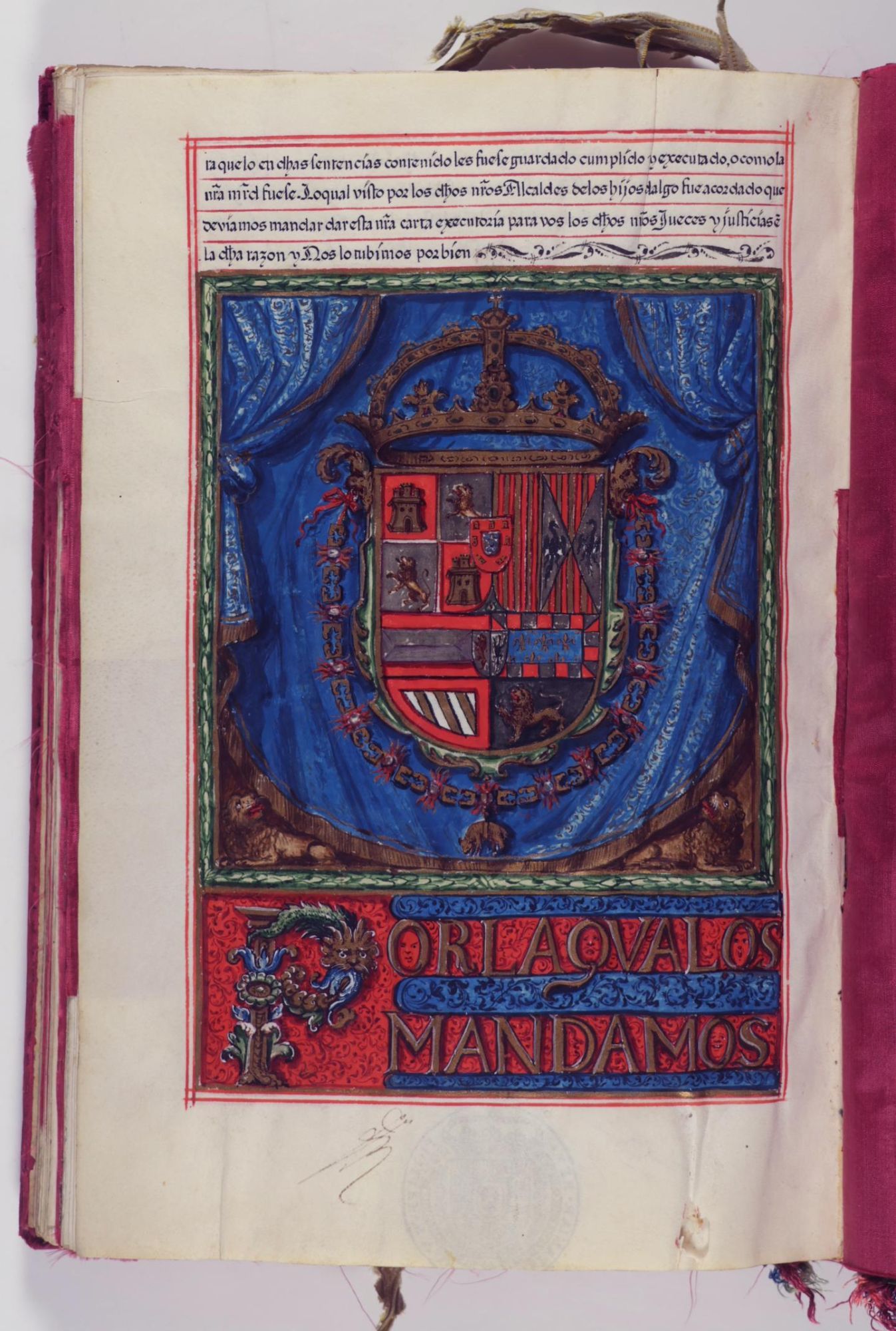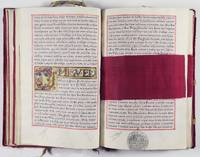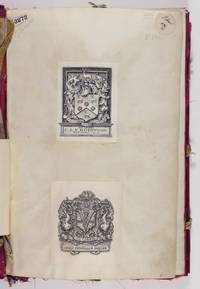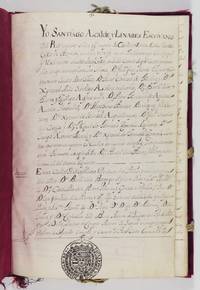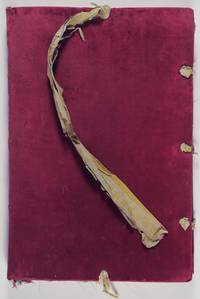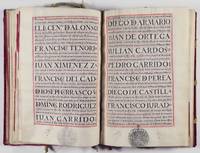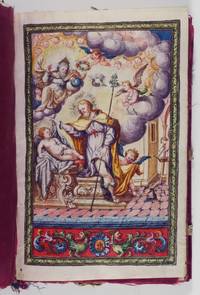Eighteeth-Century Spanish Nobility Patent for the De la Barra Family [FINELY ILLUMINATED MANUSCRIPT]
- SIGNED Hardcover
- [Spain]: [Chancellary Court of Granada], 1721
[Spain]: [Chancellary Court of Granada], 1721. Original manuscript. Hardcover. Fine. Small folio (33 by 22 cm / 11-7/8 by 7-7/8 in.). Illuminated manuscript on vellum. Main text in black ink, masterfully penned in fine, clear Gothic style, ruled and bordered in red. 82 unnumbered leaves (4 blank), comprising 6 full-page miniatures and 144 pages of text (generally 32 lines per page). 36 richly illuminated bands with initials appear throughout the text, with occasional ornate initials in black ink. The finely detailed miniatures are painted in rich colors, and decorated with metallic gold and silver. The royal seal of Philip V of Spain is stamped in black ink at the bottom margin on the recto of all text leaves, as well as the final three blanks; the initials of a royal notary appear at the bottom margin of each page of text. Bound in contemporary crimson velvet (lightly rubbed) with decorative brocade ribbon ties (worn and frayed). All edges gilt; crimson silk guards bound-in to protect the miniatures and illuminated bands. Text in Spanish. Manuscript on vellum fine and clean throughout. Overall a very well-preserved bound document.
Sumptuously illustrated 18th-century manuscript nobility patent (carta ejecutoria de hidalguia) commissioned by the De la Barra family of Castile to memorialize the recognition of its noble status in the reign of Philip V, King of Spain. As depicted in the illustrated family tree and noted at the opening of the text, the family traces their noble ancestry, back through five generations, to Don Bartholome de la Barra y Zuñiga. "During the late medieval era, many individuals received the honor of hidalgo status [the lowest rank of nobility], but with the passage of time, this noble status was not always locally recognized. If a person or family was willing to submit a documented family history to local officials of the Chamber of Hijosdalgo of the Chancellery Court of either Valladolid of Granada, they could sue for formal recognition" (Neary). While few succeeded in these suits, those who did would often commission luxury copies of the paperwork, bound with the royal seal.
While customized for each family, the text and images of these nobility patents follow a standardized template which must elaborate on three key themes: religious devotion; service to the crown; and purity of blood (limpieza de sangre). The latter required that the family demonstrate the absence of Jewish, Muslim, or "heretical" ancestry. As is commonly the case, the present example opens with an image of the Virgin Mary, here receiving the devotion of four members of the De la Barra family, depicted on their knees before a sumptuously appointed church altar. The facing image depicts the Father, the Son, and the Holy Spirit (in the form of a dove), looking down upon the infant Jesus. The other full-page miniatures depict the De la Barra family tree; their coat of arms, King Philip V; and the royal coat of arms. The richly illuminated bands contain the names of De la Barra family members or introduce key sequences in the presentation and disposition of the suit. The final four pages of text comprise an official copy of the court's final decision. Penned in an ordinary scribal hand, this concluding document was usually written on paper; in the present case the declaration appears on parchment, at the special request of the family. The document is signed by Santiago Alcalde y Linares, royal notary (escribano), and dated 3 July, 1721.
Provenance: The engraved bookplates of C. L. F. Robinson, Newport, Rhode Island, and Mary MacMillin Norton appear on the opening blank leaf. Charles L. F. Robinson (1874-1916), described in the auction sale catalogue of his library as "a liberal and discriminating collector of rare books" who acquired many volumes from the Hoe and Huth collections, was best known as a collector of rare Americana. A clipping from the auction catalogue (lot 595) describing the present manuscript is laid in; a typescript of the description is tipped in at the inner margin, along with another printed catalogue description, possibly from another sale. Robinson served at one time as president of the Colt Patent Firearms Manufacturing Company of Hartford, Connecticut. The Anderson Galleries, Catalogue of Rare Books Comprising the Valuable Library of the Late Col. Charles L. F. Robinson of Hartford, Conn., lot 595 (p. 136); E. A. Neary, "Spanish Golden Age Nobility Documents" [in:] Digital Collections for the Classroom. Online via Newberry Library (April 13, 2023).
Sumptuously illustrated 18th-century manuscript nobility patent (carta ejecutoria de hidalguia) commissioned by the De la Barra family of Castile to memorialize the recognition of its noble status in the reign of Philip V, King of Spain. As depicted in the illustrated family tree and noted at the opening of the text, the family traces their noble ancestry, back through five generations, to Don Bartholome de la Barra y Zuñiga. "During the late medieval era, many individuals received the honor of hidalgo status [the lowest rank of nobility], but with the passage of time, this noble status was not always locally recognized. If a person or family was willing to submit a documented family history to local officials of the Chamber of Hijosdalgo of the Chancellery Court of either Valladolid of Granada, they could sue for formal recognition" (Neary). While few succeeded in these suits, those who did would often commission luxury copies of the paperwork, bound with the royal seal.
While customized for each family, the text and images of these nobility patents follow a standardized template which must elaborate on three key themes: religious devotion; service to the crown; and purity of blood (limpieza de sangre). The latter required that the family demonstrate the absence of Jewish, Muslim, or "heretical" ancestry. As is commonly the case, the present example opens with an image of the Virgin Mary, here receiving the devotion of four members of the De la Barra family, depicted on their knees before a sumptuously appointed church altar. The facing image depicts the Father, the Son, and the Holy Spirit (in the form of a dove), looking down upon the infant Jesus. The other full-page miniatures depict the De la Barra family tree; their coat of arms, King Philip V; and the royal coat of arms. The richly illuminated bands contain the names of De la Barra family members or introduce key sequences in the presentation and disposition of the suit. The final four pages of text comprise an official copy of the court's final decision. Penned in an ordinary scribal hand, this concluding document was usually written on paper; in the present case the declaration appears on parchment, at the special request of the family. The document is signed by Santiago Alcalde y Linares, royal notary (escribano), and dated 3 July, 1721.
Provenance: The engraved bookplates of C. L. F. Robinson, Newport, Rhode Island, and Mary MacMillin Norton appear on the opening blank leaf. Charles L. F. Robinson (1874-1916), described in the auction sale catalogue of his library as "a liberal and discriminating collector of rare books" who acquired many volumes from the Hoe and Huth collections, was best known as a collector of rare Americana. A clipping from the auction catalogue (lot 595) describing the present manuscript is laid in; a typescript of the description is tipped in at the inner margin, along with another printed catalogue description, possibly from another sale. Robinson served at one time as president of the Colt Patent Firearms Manufacturing Company of Hartford, Connecticut. The Anderson Galleries, Catalogue of Rare Books Comprising the Valuable Library of the Late Col. Charles L. F. Robinson of Hartford, Conn., lot 595 (p. 136); E. A. Neary, "Spanish Golden Age Nobility Documents" [in:] Digital Collections for the Classroom. Online via Newberry Library (April 13, 2023).


